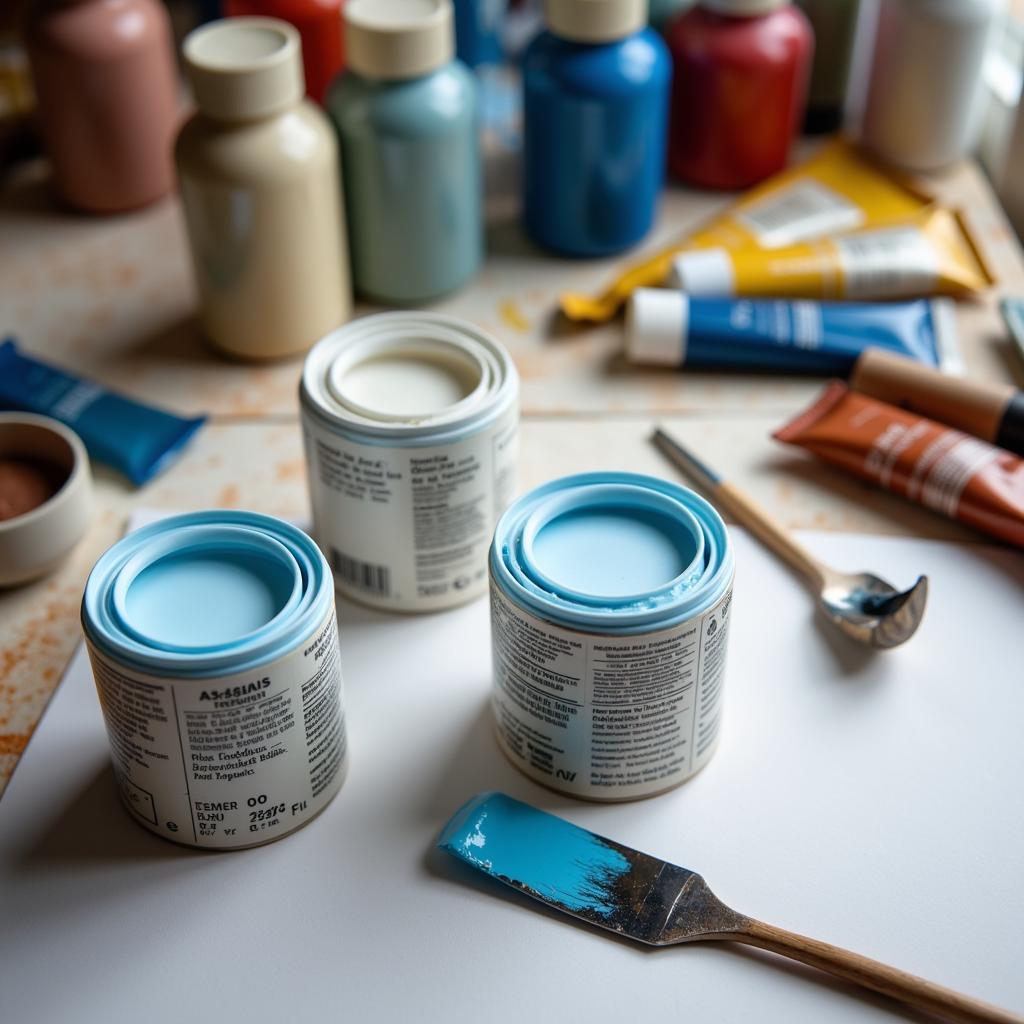Creating the perfect white isn’t as simple as grabbing a can labeled “white” off the shelf. Achieving a specific shade of white, whether for walls, trim, or a canvas, often requires a bit of mixing and understanding of undertones. So, how do you make the color white with paint? Let’s delve into the world of white paint and discover the secrets to achieving your desired hue.
 Mixing White Paint with Color Tints
Mixing White Paint with Color Tints
While you can’t create pure white from scratch by mixing other colors, you can modify existing white paint to achieve specific shades. Most pre-mixed “whites” aren’t truly white, but rather subtle variations with undertones of other colors like blue, yellow, or pink. These undertones dramatically affect how the white appears in different lighting conditions. You might be surprised to learn that adding a tiny amount of blue tint to a warm white can neutralize a yellowish cast, resulting in a crisper, cleaner white. For a warmer white, try incorporating a touch of yellow ochre or raw sienna. Can you make white paint by mixing colors? Not from scratch, but you can definitely adjust its undertone!
Understanding White Paint Undertones
The key to manipulating white paint is understanding undertones. These subtle hints of color create the warmth or coolness of a white. Common undertones include:
- Blue: Creates a crisp, clean white, often used in modern and contemporary spaces.
- Yellow: Offers a warmer, more traditional feel, often found in historic homes.
- Pink/Red: Adds a soft, romantic touch, perfect for bedrooms and nurseries.
- Green: Can create a calming, natural feel, suitable for bathrooms and living rooms.
How to Make the Color White Paint: A Step-by-Step Guide
- Choose Your Base: Start with a good quality white paint base. Look for a “tinting white” or a neutral white specifically designed for mixing.
- Identify Your Desired Undertone: Consider the room’s lighting, existing decor, and your personal preference. Do you want a warm, inviting white or a cool, modern one?
- Add Tints Gradually: Use artist-grade acrylic or oil paints for tinting. Start with just a tiny drop of your chosen tint color and mix thoroughly. Remember, a little goes a long way!
- Test on a Sample: Before committing to a full wall, paint a small section of your surface with the mixed white. Let it dry completely and observe it in different lighting conditions. This helps you avoid unexpected results, like how to make off white paint color.
- Adjust as Needed: If the color isn’t quite right, add more tint drop by drop until you achieve the desired shade. Keep careful notes of your tint ratios for future reference.
Tips for Mixing White Paint
- Use a clean palette knife or mixing stick to prevent contamination.
- Mix thoroughly to ensure even color distribution.
- Test your mixed white in various lighting conditions before applying it to a large area.
- Consider the color of your primer. A tinted primer can influence the final white color.
“Creating the perfect white is often a journey of experimentation. Don’t be afraid to try different tint combinations and observe how they interact with your space.” – Amelia Dubois, Color Consultant
How to Neutralize Yellowing White Paint
Over time, white paint can yellow due to age, exposure to sunlight, or the use of oil-based primers. How to make the color white paint look fresh again? Adding a touch of blue tint can help neutralize this yellowing and restore its brightness. This might be useful for some people who want to understand can you make white paint by mixing colors.
Conclusion
Creating the perfect white with paint involves more than just opening a can. Understanding undertones, mixing techniques, and the impact of lighting can transform your space. By following these steps and experimenting with different tints, you can achieve a custom white that perfectly complements your vision and enhances your home’s aesthetic. how to make the color white paint.
FAQ
- Can I mix white paint with other colors? Yes, you can mix white paint with other colors to create lighter tints and shades.
- What is the best white paint for walls? The best white paint depends on your desired undertone, lighting conditions, and personal preference.
- How can I prevent my white paint from yellowing? Using a high-quality, water-based paint and primer can help prevent yellowing.
- What is the difference between warm white and cool white? Warm whites have yellow, red, or pink undertones, while cool whites have blue or green undertones.
- How much tint should I add to white paint? Start with a very small amount of tint and gradually add more until you achieve the desired shade.
Common Scenarios
- Matching existing trim: Carefully analyze the undertone of your existing trim and use the same undertone in your mixed white for a seamless look.
- Creating a bright, airy space: Opt for a cool white with a blue undertone to maximize light reflection.
- Achieving a cozy, warm atmosphere: Choose a warm white with a yellow or pink undertone.
Further Exploration
For more information on color mixing, you might be interested in articles about what color does brown and blue make or even something seemingly unrelated like what color is the turtle.
Need assistance with your color choices? Contact us at 0373298888, email us at [email protected], or visit our showroom at 86 Cầu Giấy, Hà Nội. Our 24/7 customer service team is ready to help.
